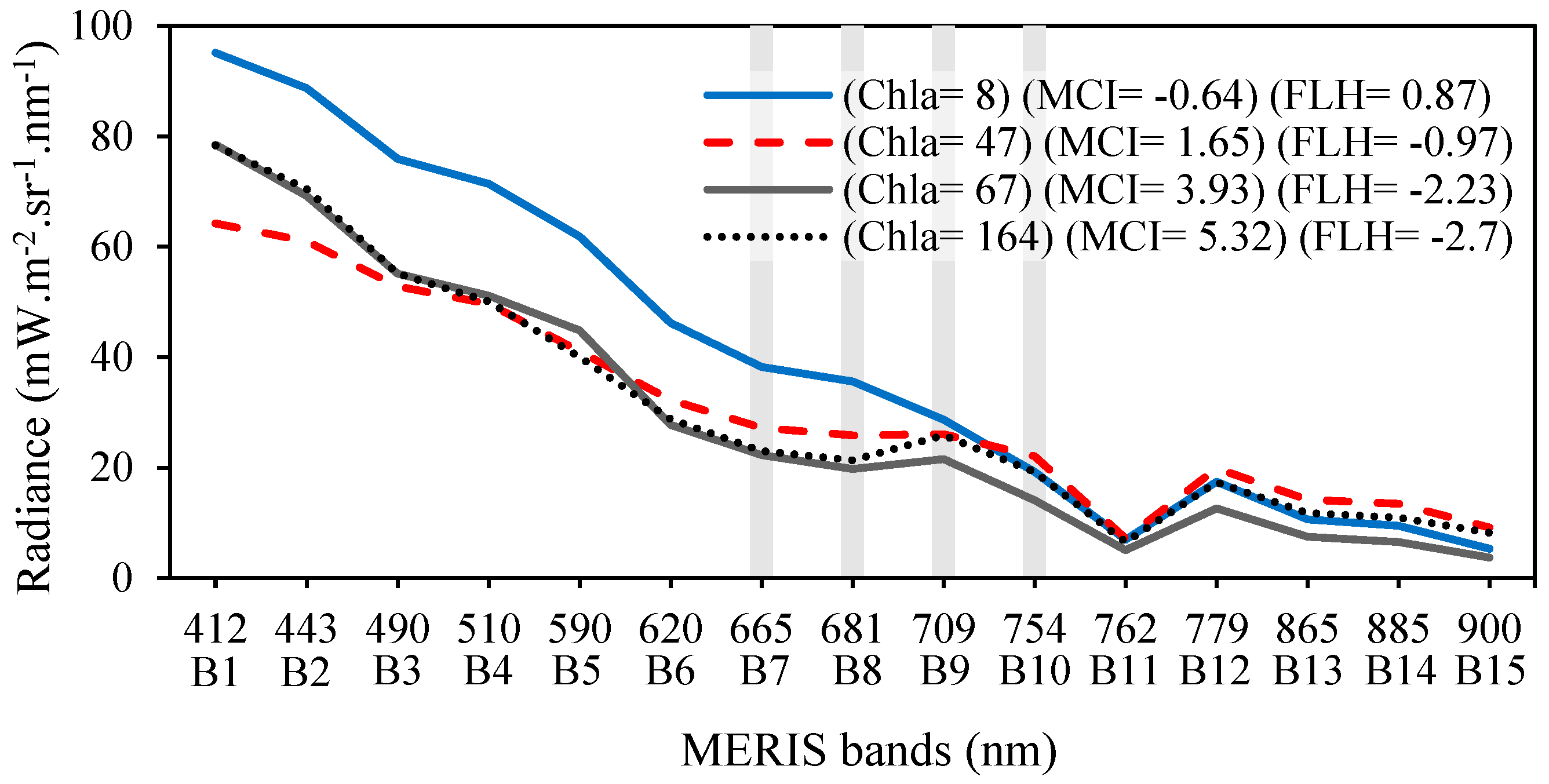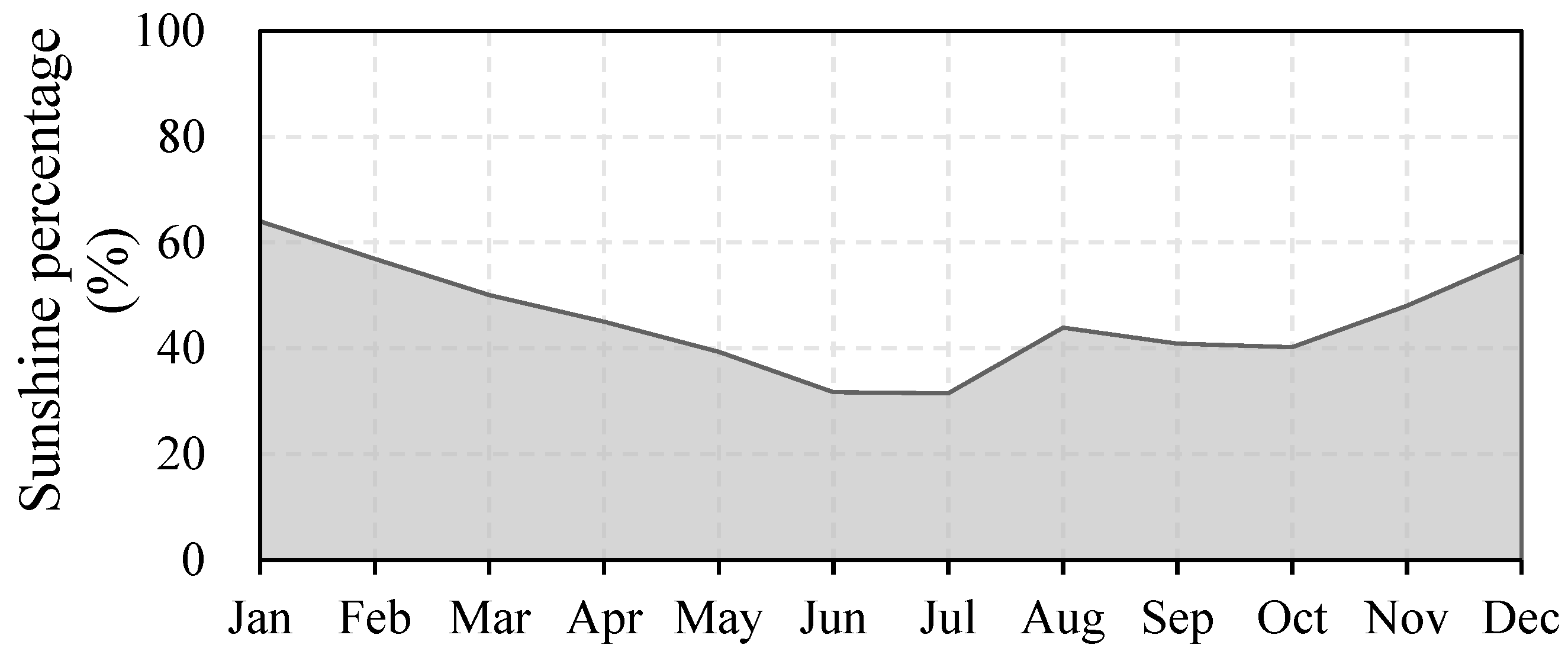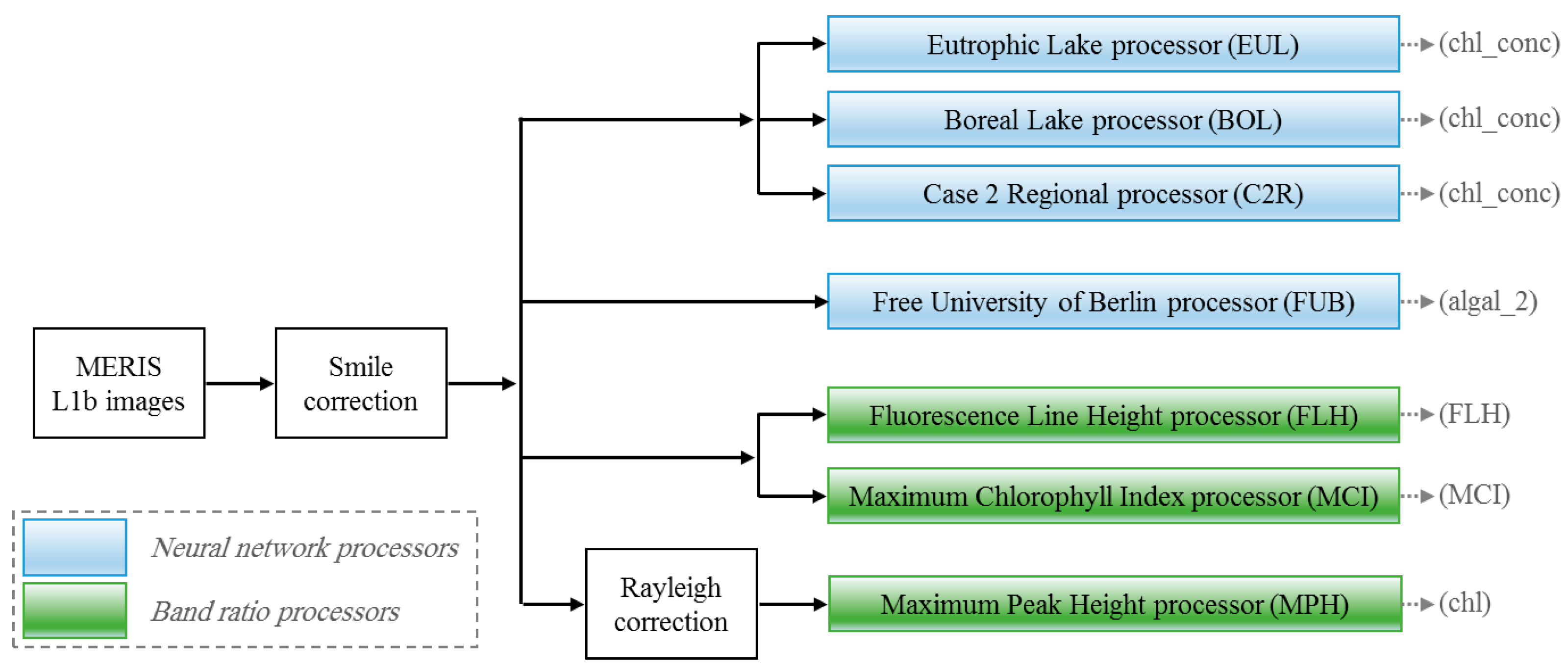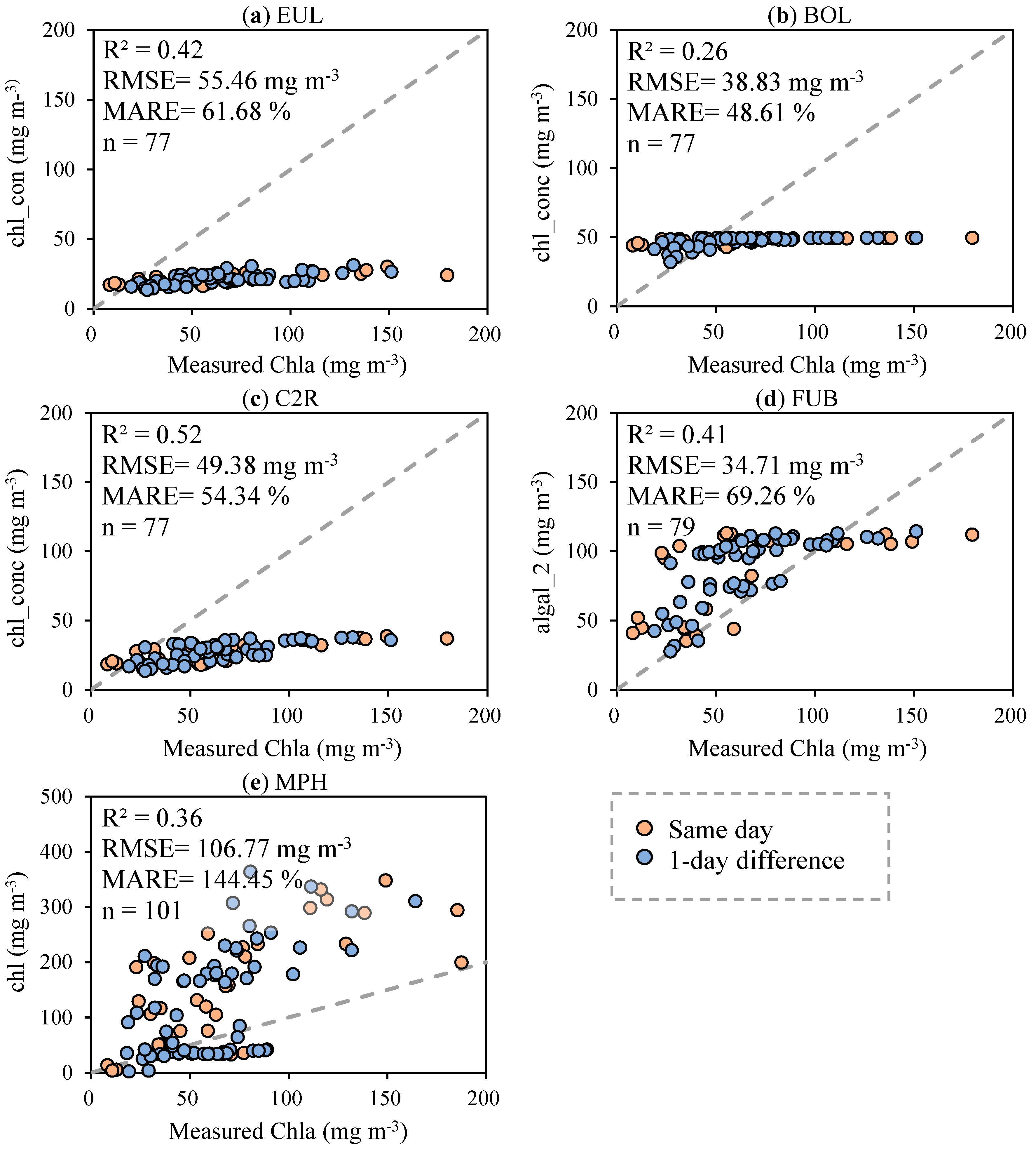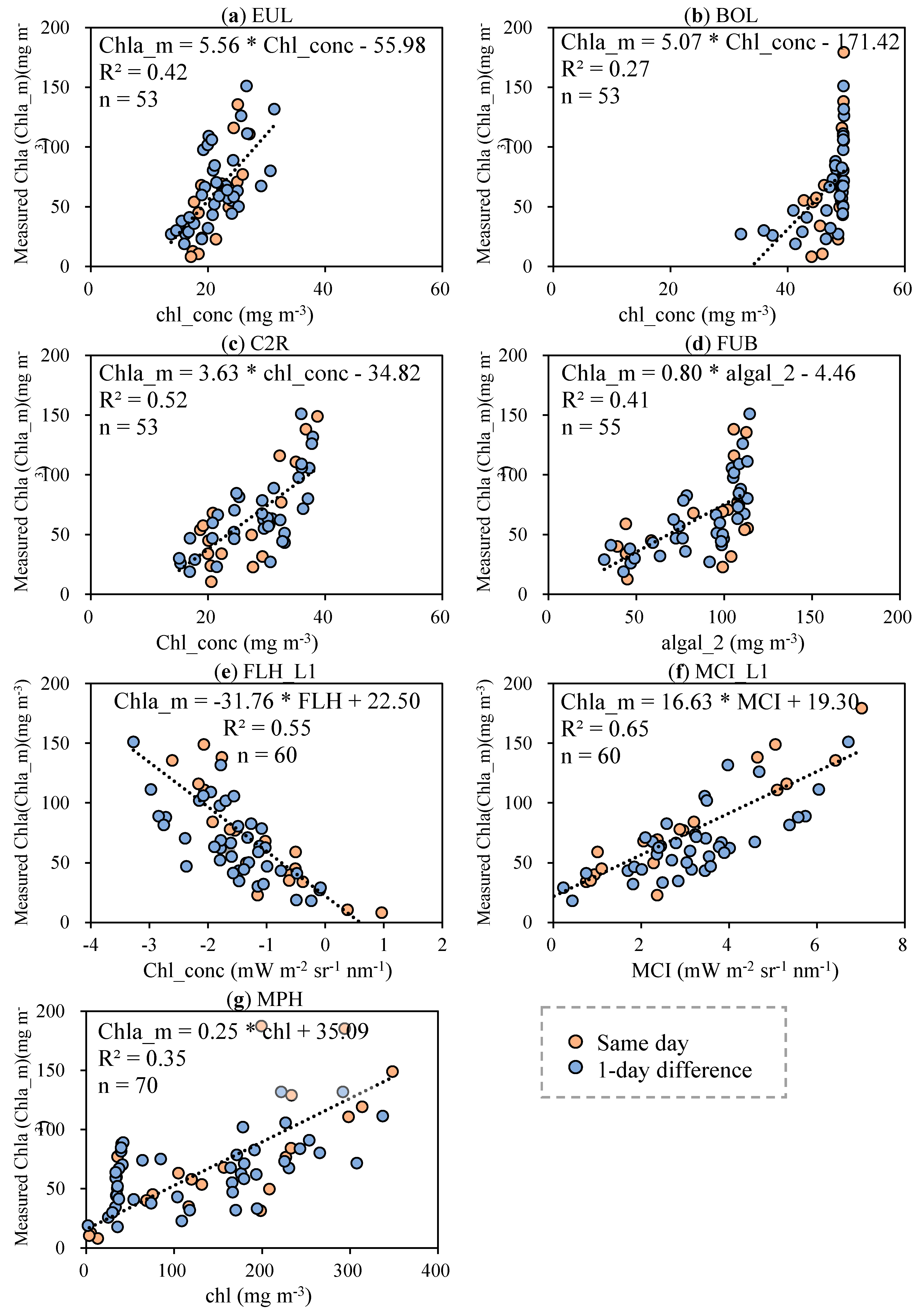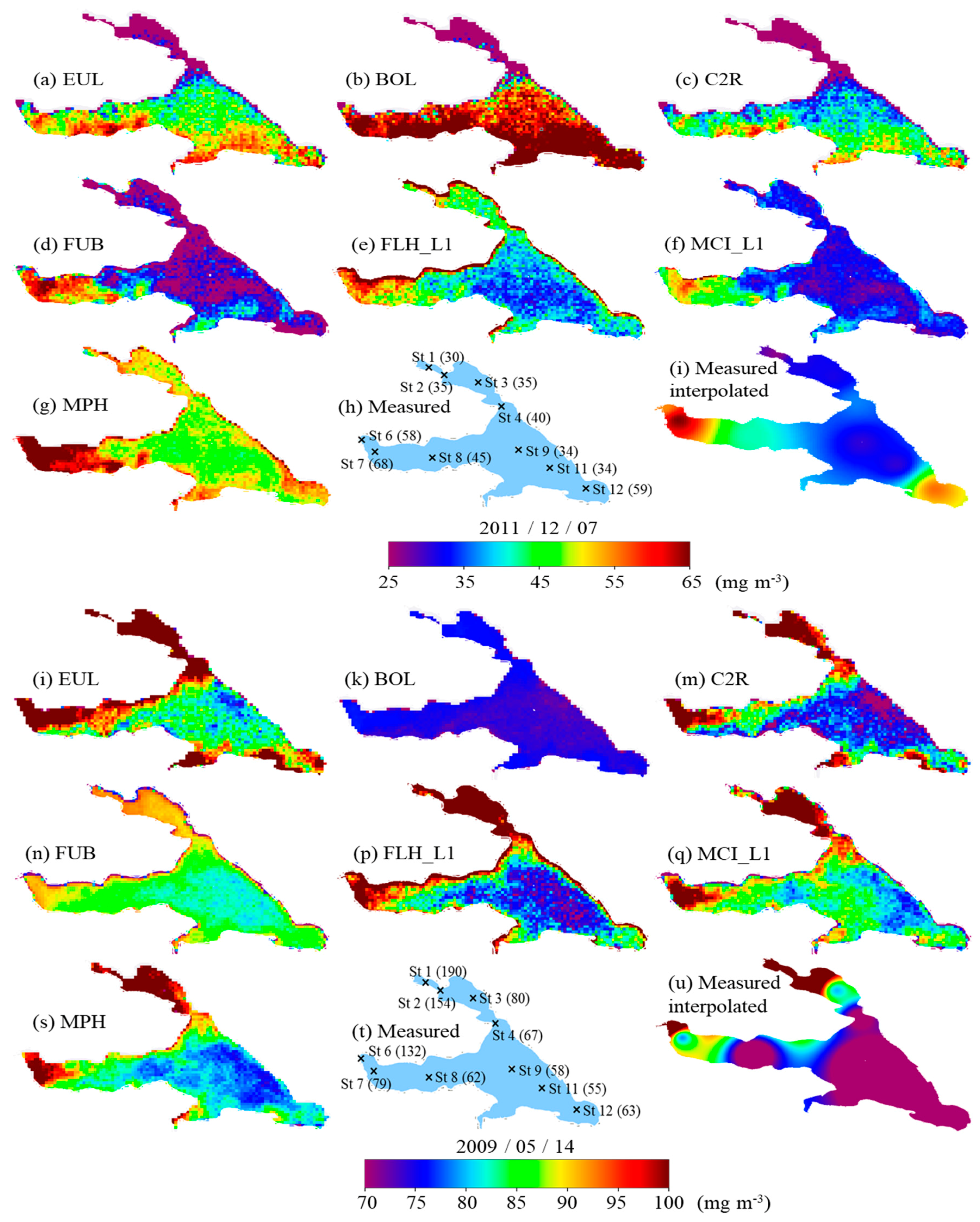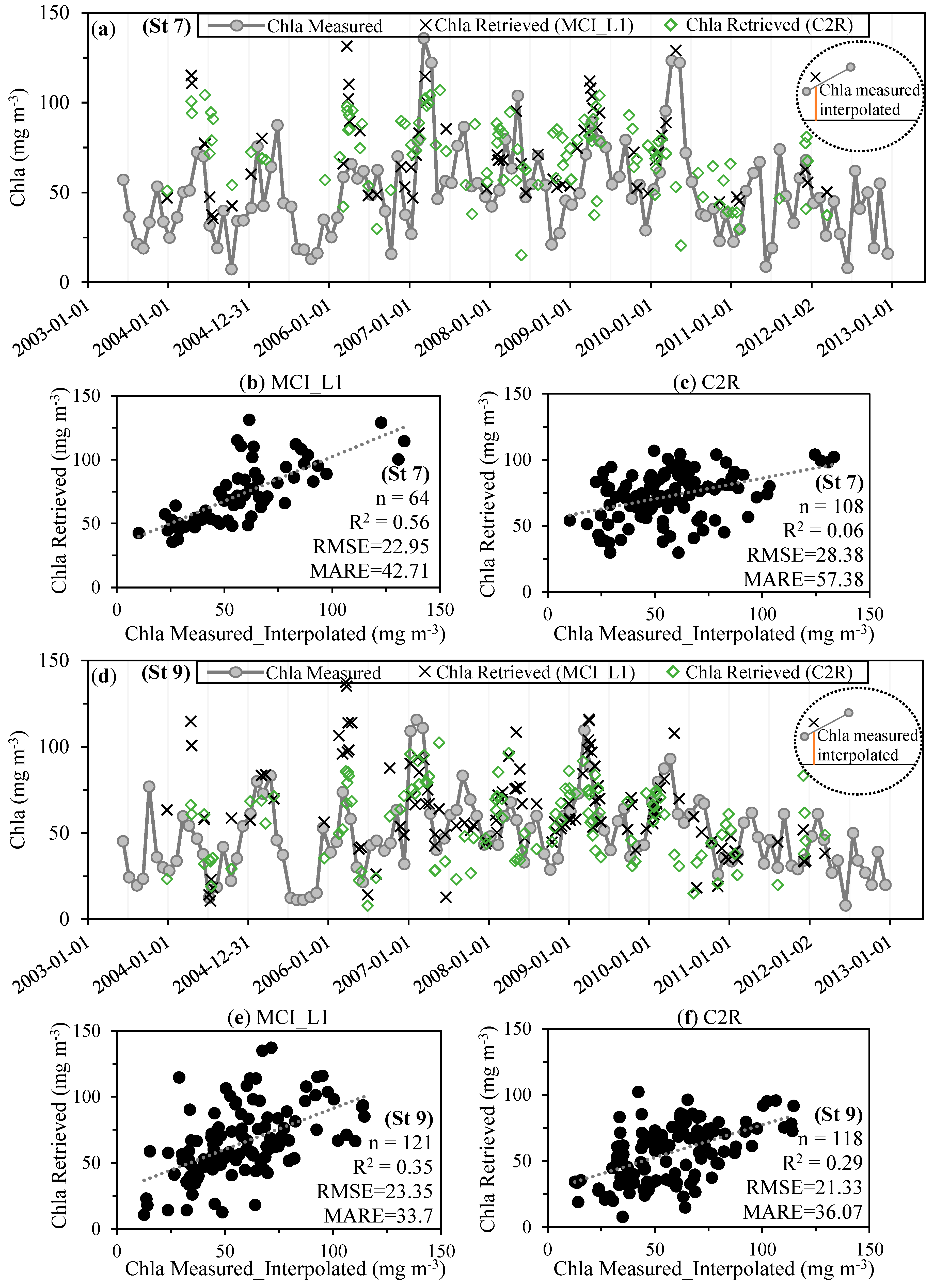3.2. Evaluation of Chlorophyll-a Retrieval Processors
Five out of the seven processors (EUL, BOL, C2R, FUB, and MPH) provide Chla concentrations, whereas the other two processors (FLH_LI and MCI_L1) produce indices. The retrieved Chla from the five processors were compared with the in situ measured Chla to evaluate their performances, as shown in
Figure 5. In general, the same day and 1-day difference match-ups were regularly distributed across different Chla concentrations without any special trend (
Figure 5), revealing the applicability of the assumption for the one-day difference between the in situ measurements and MERIS data acquisition. EUL, BOL, and C2R considerably underestimated the Chla concentration with an upper limit for the retrieved Chla of 50 mg∙m
−3 (
Figure 5a–c). Although the training dataset for the EUL processor used Chla concentrations that ranged from 1–120 mg∙m
−3 (
Table 3), the processor failed to retrieve Chla concentrations higher than 50 mg∙m
−3 (
Figure 5a), with retrieval accuracies of 0.42, 55.46 mg∙m
−3, and 61.68% for the coefficient of determination (R
2), RMSE, and MARE, respectively. The BOL processor had the lowest retrieval accuracy with a R
2 of 0.26 (
Figure 5b), whereas C2R outperformed the other processors with R
2, RMSE, MARE of 0.52, 49.38 mg∙m
−3, and 54.34%, respectively (
Figure 5c). Although the measured Chla in Lake Kasumigaura ranged between 8.10–187.40 mg∙m
−3, the retrieved Chla concentrations were <50 mg∙m
−3, due to the characteristics of the training datasets for these processors (Chla concentrations covered ranges of 0.5–50 mg∙m
−3 and 0.016–43 mg∙m
−3 for the BOL and C2R processors, respectively) as shown in
Table 3.
Although the FUB processor was the second most accurate processor (R
2 = 0.41, RMSE = 34.71 mg∙m
−3, MARE = 69.26%), it appeared that the processor inaccurately retrieved the Chla concentration at 100 mg∙m
−3 for many measured match-ups in the range of 25–180 mg∙m
−3 (
Figure 5d). In contrast to the four NN processors (EUL, BOL, C2R, and FUB), the MPH processor overestimated the retrieved Chla up to 390 mg∙m
−3 (
Figure 5e). As a result, the MPH introduced the highest RMSE and MARE of 106.77 mg∙m
−3 and 144.45%, respectively.
3.3. Processors Adjustment
As clearly shown in
Figure 5, the five processors either underestimated or overestimated the retrieved Chla. A regression approach was therefore used to adjust the inaccurate Chla retrieval from the five processors. In addition, the regression approach was also incorporated to establish a relationship between the measured Chla and the indices of the FLH_L1 and MCI_L1 processors. The derived relationship was used to retrieve Chla concentrations from the indices of FLH_L1 and MCI_L1. Salem et al. [
56] found that the differences in retrieval accuracies among linear, quadratic polynomial, and power regression approaches were relatively small for the measured dataset. Linear regression was therefore adopted during this research. The match-ups for each processor were split into a 7:3 ratio for calibration to drive the relationship between the measured Chla and the processors’ outputs (which could be Chla concentrations or indices and validation stages), respectively.
The performance of each processor in terms of R
2, as well as the derived relationship, are summarized in
Table 6 for the calibration stage. The MCI_L1 outperformed the other processors (R
2 = 0.65), as shown in
Figure 6f. The second tier of processors was the FLH_L1 and C2R with R
2 of 0.55 and 0.52, respectively (
Figure 5c,e). The FLH_L1 provided positive values for Chla concentrations ≤10 mg∙m
−3 as the influence of fluorescence at 681-nm was much stronger than the influence of particle scattering at 709-nm. However, particle scattering significantly increased the radiance at 709-nm for Chla concentrations above 10 mg∙m
−3, creating negative FLH height values at 681-nm from the baseline between 665-nm and 709-nm [
57] (
Figure 6e).
Figure 5b shows the BOL processor had the lowest retrieval accuracy (R
2 = 0.27). The poor retrieval accuracy of the BOL processor was attributed to the fact that the Finnish lakes used to train the processor are not eutrophic water bodies, therefore resulting in unrealistically low Chla concentrations, as reported by Shi et al. [
16].
The seven processors in
Figure 6 were classified into two groups—the first group consisted of EUL, C2R, MCI_L1, and FLH_L processors; and the second group consisted of BOL, FUB, and MPH processors. The first group showed a relatively close similarity between the measured and retrieved Chla concentrations (
Figure 5a,c,e,f). The second group, on the other hand, failed to retrieve Chla concentrations from MERIS data by producing the same retrieved Chla concentration under different conditions. For example, the BOL processor retrieved Chla concentrations around 50 mg∙m
−3 for the measured Chla in the range of 25–180 mg∙m
−3 for many stations (
Figure 6b). Similarly, the FUB retrieved inaccurate Chla concentrations of around 120 mg∙m
−3 (
Figure 6d). The MPH also had a similar trend of around 40 mg∙m
−3; however, this trend was located within the limits of the retrieved Chla, thus demonstrating the need to revise the conditions and thresholds of MPH to find the possible causes of this error.
During the validation stage, the outputs of each processor (Chla concentrations or indices) were substituted into the derived relationship from the calibration stage to obtain the retrieved Chla concentrations. The MCI_L1 algorithms had the highest R
2 of 0.65 and the lowest RMSE of 22.18 mg∙m
−3 among the seven processors (
Figure 7f). The second most accurate processors were FLH_L1 (R
2 = 0.56, RMSE = 25.80 mg∙m
−3, MARE = 34.52%) and C2R (R
2 = 0.53, RMSE = 26.34 mg∙m
−3, MARE = 48.73%), as illustrated in
Figure 7e,c respectively. Though both FLH_L1 and MCI_L1 processors were developed to monitor turbid water bodies, they were found to be able to retrieve low Chla concentrations, as shown in
Figure 6f and
Figure 7e, respectively.
Although the EUL processor was developed for turbid Case 2 waters and trained with Chla concentrations up to 120 mg∙m
−3 (
Table 3), it showed intermediate retrieval accuracy with R
2, RMSE, and MARE of 0.42, 29.67 mg∙m
−3 and 33.38%, respectively. The retrieved Chla was consistent with the in situ measured Chla for the EUL, C2R, FLH_L1, and MCI_L1 processors, and generally followed the 1:1 line for Chla concentrations ≤100 mg∙m
−3. However, the four processors tended to underestimate the retrieved Chla concentrations >100 mg∙m
−3 (
Figure 7a,c,e,f).
The BOL, FUB, and MPH processors introduced the highest MARE values of 56.20, 57.00 and 59.54%, respectively. The limitation of the three processors to accurately retrieve Chla concentrations from the MERIS data was evident from the data, as shown in
Figure 7b (retrieved Chla around 80 mg∙m
−3),
Figure 7d (retrieved Chla around 80 mg∙m
−3), and
Figure 7g (retrieved Chla around 40 mg∙m
−3),. The MCI_L1 and FLH_L1 processors required MERIS L1b radiance as an input, which avoided errors arising from atmospheric correction. In addition, the NN processors incorporated a regression approach to adjust their outputs, which revealed the need to retrain the NN processors with a simulated dataset covering wider trophic statuses to retrieve accurate products without a regression approach. The FLH_L1 and MCI_L1 processors provided high retrieval accuracy during the calibration and validation stages of the current study, as well as for other studies that compared the NN processors with the band height processors (
Table 6). Consequently, the MCI_L1 and FLH_L1 processors are recommended for MERIS data.
To further investigate the ability of the seven processors to capture the spatial distribution of Chla concentrations throughout Lake Kasumigaura, two MERIS images—one acquired on 7 December 2011 and another on 14 May 2009—were selected to represent moderate and high Chla concentrations, respectively. For each image, Chla concentrations or indices were generated using the seven processors and the relationships derived during the calibration stage were used to provide the adjusted Chla concentrations, as shown in
Figure 8a–g,i–s. The measured Chla at ten sampling points are illustrated in
Figure 8h,t. The measured Chla concentrations were interpolated using the Kriging technique [
58] via, ArcGIS 10.3 to produce the spatial distribution of the measured Chla across the lake as shown in
Figure 8i,u.
The measured Chla in
Figure 8h,t indicated that Lake Kasumigaura was y-shaped with relatively high Chla concentrations along both of its branches due to nutrient-rich inflow from rivers near St. 1 (Sakura and Hanamura River) and St. 6 (Koise River). However, the remainder of the lake was subjected to relatively moderate Chla concentrations. The EUL, C2R, FLH_L1, and MCI_L1 processors introduced a relatively accurate trend for Chla distribution when compared with the measured Chla (
Figure 8a,c,e,f,i,m,p,q). The MCI_L1 provided the most accurate image for the moderate Chla concentration in December 2011 (
Figure 8f) when compared with the measured Chla (
Figure 8h,i). Although the EUL, C2R, and FLH produced very similar distributions to the measured concentration for the MERIS image in May 2009, C2R (
Figure 8c) showed the closest distribution to the measured concentration (
Figure 8t,u). The MPH processor had a reasonable trend of Chla, with an overestimation of retrieved Chla in December 2011 (
Figure 8g,s). Both the BOL and FUB processors failed to capture the Chla distribution for moderate and high concentrations, particularly in May 2009, as they produced almost uniform Chla concentrations of 80–90 mg∙m
−3.
The seven processors represented two categories: neural networks and band height processors. One processor was selected from each category to evaluate their retrieval accuracy over the 10-year MERIS mission. The MCI_L1 and C2R processors were selected as they not only provided the highest R
2 values during the calibration and validation stages but also represent band height and NN processors, respectively. A total of 122 clear or partially clear MERIS images were first processed using MCI_L1 and C2R processors following the procedure shown in
Figure 4. Next, the relationships derived during the calibration stage were used to obtain the retrieved adjusted Chla. Chla concentrations have been measured monthly at ten stations at Lake Kasumigaura since the 1970s by NIES [
39].
Figure 9a,d show the time series of measured Chla at St. 7 and St. 9, respectively. Additionally, the retrieved adjusted Chla from the MCI_L1 and C2R processors are illustrated in
Figure 9a,d.
A visual comparison between the measured and retrieved Chla from the MCI_L1 and C2R processors revealed that both processors could follow the seasonal and annual patterns of Chla concentration from 2002–2012 (
Figure 9a,d). The retrieved Chla concentrations from MCI_L1 were relatively more accurate than the retrieved Chla concentrations from C2R. Despite this, the MCI_L1 tended to overestimate the retrieved Chla during the spring seasons of 2004, 2006, 2008 and 2009 (
Figure 9a,d). Diatoms usually bloom between April and June in Lake Kasumigaura [
40], which might have caused this error—further investigation is necessary to examine the possible influence of phytoplankton species on the processors’ performances.
The main limitation of performing a quantitative evaluation of the retrieved Chla from the MCI_L1 and C2R processors was that there are only 13 out of the 122 images synchronized the in situ measurements with only one-day difference. To overcome this limitation, the measured Chla were linearly interpolated to match the dates of the MERIS images. The comparison between the measured interpolated Chla and the retrieved Chla demonstrated that the MCI_L1 provided better retrieval accuracy than C2R in terms of R
2 at St. 7 (R
2 = 0.56) and St. 9 (R
2 = 0.35), as shown in
Figure 9b,e, respectively.

